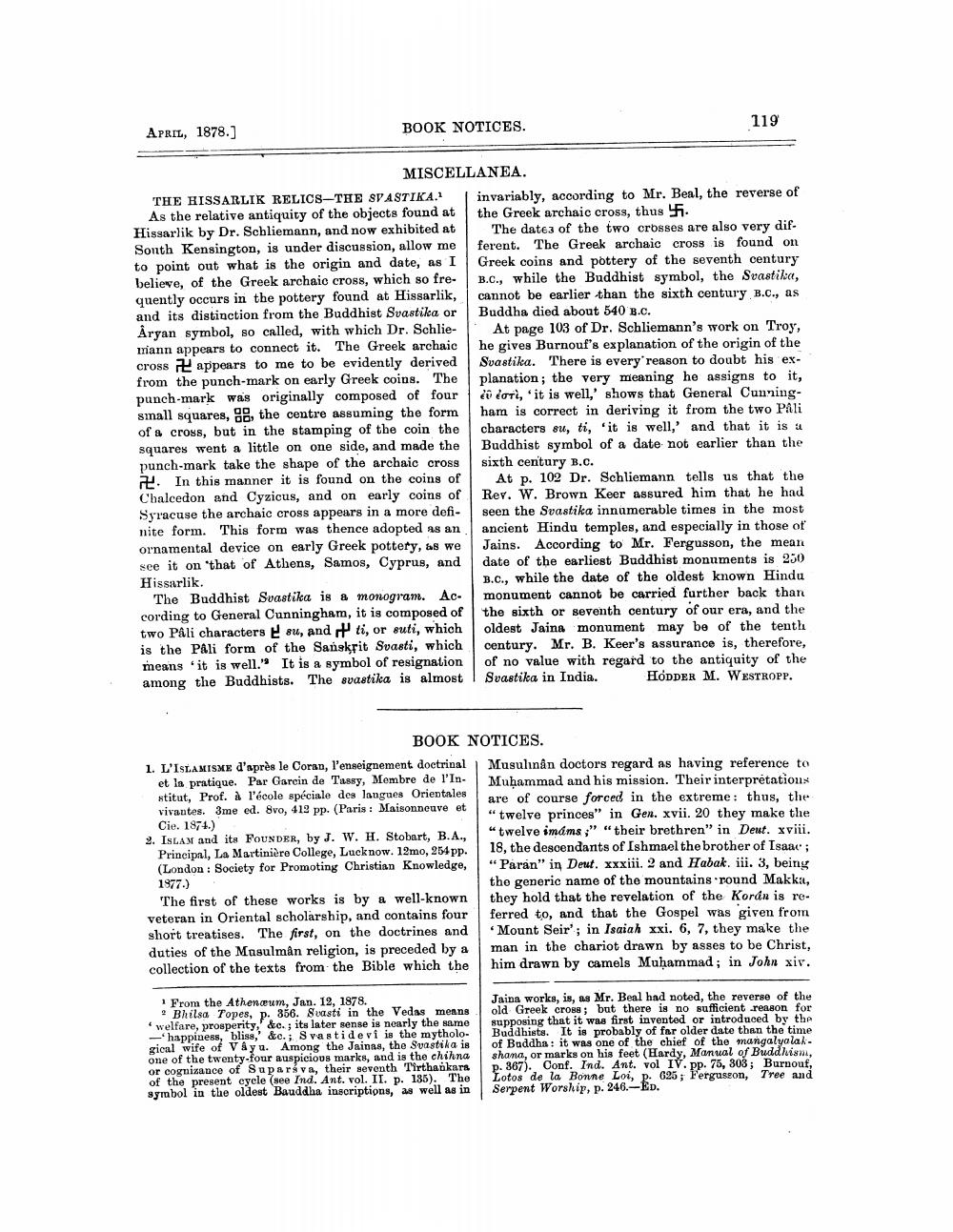________________
APRIL, 1878.)
BOOK NOTICES.
119
MISCELLANEA. THE HISSARLIK RELICS-THE SVASTIKA. invariably, according to Mr. Beal, the reverse of
As the relative antiquity of the objects found at the Greek archaic cross, thus H. Hissarlik by Dr. Schliemann, and now exhibited at 1 The date of the two crosses are also very difSonth Kensington, is under discussion, allow me ferent. The Greek archaic cross is found on to point out what is the origin and date, as I Greek coins and pottery of the seventh century believe, of the Greek archaic cross, which so fre- B.C., while the Buddhist symbol, the Svastika, quently occurs in the pottery found at Hissarlik, cannot be earlier than the sixth century B.C., as and its distinction from the Buddhist Svastika or Buddha died about 540 B.C. Aryan symbol, so called, with which Dr. Schlie- At page 103 of Dr. Schliemann's work on Troy, mann appears to connect it. The Greek archaic he gives Burnouf's explanation of the origin of the cross it appears to me to be evidently derived Svastika. There is every reason to doubt his exfrom the punch-mark on early Greek coins. The planation; the very meaning he assigns to it, punch-mark was originally composed of four Ülori, 'it is well,' shows that General Cunningsmall squares, B, the centre assuming the form ham is correct in deriving it from the two PAli of a cross, but in the stamping of the coin the characters su, ti, 'it is well,' and that it is a squares went a little on one side, and made the Buddhist symbol of a date not earlier than the punch-mark take the shape of the archaic cross sixth century B.C.
2. In this manner it is found on the coins of At p. 102 Dr. Schliemann tells us that the Chalcedon and Cyzicus, and on early coins of Rev. W. Brown Keer assured him that he k Syracuse the archaic cross appears in a more defi-| seen the Svastika innumerable times in the most nite form. This form was thence adopted as an ancient Hindu temples, and especially in those of ornamental device on early Greek pottery, as we Jains. According to Mr. Fergusson, the mean see it on that of Athens, Samos, Cyprus, and date of the earliest Buddhist monuments is 230 Hissarlik.
B.C., while the date of the oldest known Hindu The Buddhist Svastika is a monogram. Ac- monument cannot be carried further back than cording to General Cunningham, it is composed of the sixth or seventh century of our era, and the two PAli characters su, and ti, or suti, which oldest Jaina monument may be of the tenth is the PAli form of the Sanskrit Svasti, which century. Mr. B. Keer's assurance is, therefore, means "it is well." It is a symbol of resignation of no value with regard to the antiquity of the among the Buddhists. The svastika is almost Svastika in India. HODDER M. W ESTROPP.
BOOK NOTICES. 1. L'ISLAMISME d'après le Coran, l'enseignement doctrinal Musulinan doctors regard as having reference to
et la pratique. Par Garcin de Tassy, Membre de l'In- Muhammad and his mission. Their interprétations stitut, Prof. à l'école spéciale des langues Orientales
are of course forced in the extreme: thus, the vivantes. 3me ed. 8vo, 412 pp. (Paris : Maisonneuve et
"twelve princes" in Gen. xvii. 20 they make the Cie. 1874.) 2. Islam and its FOUNDER, by J. W. H. Stobart, B.A., "twelve imams;" "their brethren" in Deut. xviii. Principal, La Martinière College, Lucknow. 12mo, 254 pp.
18, the descendants of Ishmael the brother of Isaac; (London: Society for Promoting Christian Knowledge, “Paran" in Deut. xxxiii. 2 and Habak. iii. 3, being 1877.)
the generic name of the mountains round Makka, The first of these works is by a well-known they hold that the revelation of the Kordn is reveteran in Oriental scholarship, and contains four ferred to, and that the Gospel was given from short treatises. The first, on the doctrines and Mount Seir'; in Isaiah xxi. 6, 7, they make the duties of the Masulmán religion, is preceded by a man in the chariot drawn by asses to be Christ, collection of the texts from the Bible which the him drawn by camels Muhammad ; in John xiv.
From the Athenaeum, Jan. 12, 1878. 2 Bhilsa Topes, p. 356. Suasti in the Vedas means welfare, prosperity, &c.; its later sense is nearly the same
happiness, bliss,' &c.; Svastidevi is the mythological wife of Vayu. Among the Jainas, the Svastika is one of the twenty-four auspicious marks, and is the chihna or cognizance of Suparsva, their seventh Tirthankars of the present cycle (see Ind. Ant. vol. II. p. 135). The symbol in the oldest Bauddha inscriptions, as well as in
Jainn works, is, as Mr. Beal had noted, the reverse of the old Greek cross; but there is no sufficient reason for supposing that it was first invented or introduced by the Buddhists. It is probably of for older date than the time of Buddha : it was one of the chief of the mangalyalak. shana, or marks on his feet (Hardy, Manual of Buddhism,
p. 867). Conf. Ind. Ant. vol IV. pp. 75, 803; Burnout, | Lotos de la Bonne Loi, p. 625; Fergusson, Tree and
Serpent Worship, p. 246.-ED.




